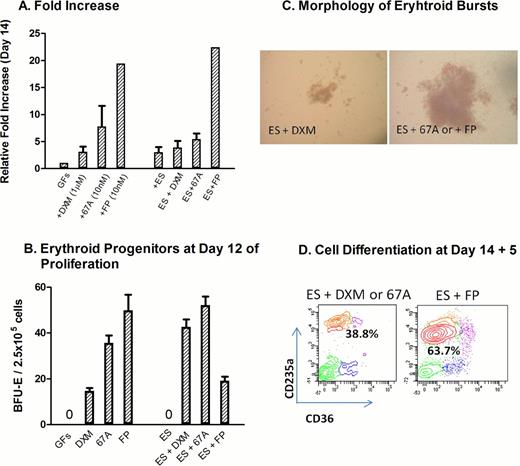Abstract
Abstract 3195
The role of glucocorticoids in erythropoiesis is substanciated by the erythrocytosis observed in Cushing's syndrome and failure in glucocorticoid receptor (GR) knockouts to respond to anaemia. Hydrocortisone, the natural GR agonist, synergizes with erythropoietin (EPO) to sustain the generation of erythroid bursts in cultures. This combined approach can be used to generate ex-vivo large numbers of erythroid cells from marginal stem cell sources [mononuclear cells (MNC) from low volume cord blood or blood donations] in liquid cultures, defined as Human Erythroid Massive Amplification (HEMA) cultures, stimulated with SCF, IL-3, EPO (GFs), estradiol (ES) and dexamethasone (DXM), a synthetic GR agonist more potent than hydrocortisone. Experiments in mice and human cells have indicated that GR activation mediates erythroid expansion by blocking terminal maturation of erythroid precursors and inducing these cells into a reversible self-replication state. By gene expression profiling, we have identified that erythroid precursors obtained in vitro with DXM express higher levels of genes controlling lipid metabolism than those obtained without DXM (see abstract by Hricik et al). Since ∼half of the human red cell mass is constituted by lipids, this over-expression suggests that the erythroid stimulating activity of GR may include its metabolic effects.
Synthetic glucocorticoids are the most potent anti-inflammatory agents known but metabolic side effects limit their clinical utility. The availability of the crystal structure of GR has fostered studies to design synthetic agonists more potent than DXM and/or lacking its undesired metabolic action. These studies have identified fluticasone (FP), a potent analogue currently used in asthma treatment. More recently non-steroidal agonists, such as 67A, have been developed which lack mineralocorticoid effects. Both FP and 67A bind GR with 100-fold increased affinity compared to DXM, and function as full agonists (Ray D, manuscript in preparation).
The aim of this study was to clarify whether the metabolic activity of GR contributes to its erythroid stimulating effects in vitro by comparing the efficacy of 67A, FP and DXM under HEMA conditions. MNC from 2 blood donors were cultured under HEMA conditions stimulated with GFs plus DXM (1 mM) or 67A (1, 3 or 10 nM), or FP (1, 3 and 10 nM), either alone or in combination with ES (1 mM). The cells were cultured for 17 days and the number and morphology (FACS profiling for CD36 and CD235a) of the progeny evaluated at day 7, 10, 12, 14 and 17. At day 12, the frequency of progenitor cells generated under the various conditions was also evaluated while the maturation potential of cells obtained at day 14 was evaluated in differentiation cultures stimulated with EPO and insulin.
MNC generated more erythroid cells [relative fold increase (FI) with respect to GFs alone: 7- or 20-fold for 67A or FP, 10 nM each] and for longer time (maximal cell numbers were observed after 17 days of culture instead of 12) if cultured with 67A and FP, instead of DXM (relative FI with respect to GFs alone: 3-fold) (Fig. A). The effects of 67A and FP were concentration dependent and maximal effects were observed with 10 nM in both cases (not shown). Addition of ES did not increase the number of erythroid cells generated in liquid cultures and increased the number of BFU-E persisting up to day 12 only in combination with DXM (Fig. B). BFU-E from 67A- and FP-stimulated cultures generated larger and better hemoglobinized colonies than BFU-E from DXM-stimulated cultures (Fig. C), suggesting that 67A and FP were equally potent at the progenitor cell level. However, day 14 erythroid precursors from FP-stimulated cultures matured better (greater frequency of CD36negCD235alow cells and darker red pellet) with EPO and insulin than those generated with 67A or DXM (Fig. D and not shown).
These results indicate that as predicted by the relative affinity for GR of the different compounds, 10 nM of 67A and FP induce levels of in vitro erythroid expansion greater, in terms of extent and duration of expansion and persistence of erythroid progenitor cells, than 1 mM of DXM. However, the numbers and maturation ability of erythroid precursors generated with 67A, which lacks mineralocorticoid activity, are lower than those of erythroid precursors generated with FP, suggesting that the metabolic activity of GR is an essential component of its erythroid stimulating activity.
No relevant conflicts of interest to declare.
Author notes
Asterisk with author names denotes non-ASH members.


This feature is available to Subscribers Only
Sign In or Create an Account Close Modal